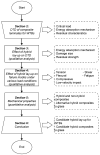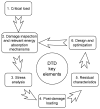A Review of Damage Tolerance and Mechanical Behavior of Interlayer Hybrid Fiber Composites for Wind Turbine Blades
- PMID: 40428951
- PMCID: PMC12112813
- DOI: 10.3390/ma18102214
A Review of Damage Tolerance and Mechanical Behavior of Interlayer Hybrid Fiber Composites for Wind Turbine Blades
Abstract
This review investigates interlayer hybrid fiber composites for wind turbine blades (WTBs), focusing on their potential to enhance blade damage tolerance and maintain structural integrity. The objectives of this review are: (I) to assess the effect of different hybrid lay-up configurations on the damage tolerance and failure analysis of interlayer hybrid fiber composites and (II) to identify potential fiber combinations for WTBs to supplement or replace existing glass fibers. Our method involves comprehensive qualitative and quantitative analyses of the existing literature. Qualitatively, we assess the damage tolerance-with an emphasis on impact load-and failure analysis under blades operational load of six distinct hybrid lay-up configurations. Quantitatively, we compare tensile and flexural properties-essential for WTBs structural integrity-of hybrid and glass composites. The qualitative review reveals that placing high elongation (HE)-low stiffness (LS) fibers, e.g., glass, on the impacted side reduces damage size and improves residual properties of hybrid composites. Placing low elongation (LE)-high stiffness (HS) fibers, e.g., carbon, in middle layers, protects them during impact load and equips hybrid composites with mechanisms that delay failure under various load conditions. A sandwich lay-up with HE-LS fibers on the outermost and LE-HS fibers in the innermost layers provides the best balance between structural integrity and post-impact residual properties. This lay-up benefits from synergistic effects, including fiber bridging, enhanced buckling resistance, and the mitigation of LE-HS fiber breakage. Quantitatively, hybrid synthetic/natural composites demonstrate nearly a twofold improvement in mechanical properties compared to natural fiber composites. Negligible enhancement (typically 10%) is observed for hybrid synthetic/synthetic composites relative to synthetic fiber composites. Additionally, glass/carbon, glass/flax, and carbon/flax composites are potential alternatives to present glass laminates in WTBs. This review is novel as it is the first attempt to identify suitable interlayer hybrid fiber composites for WTBs.
Keywords: composite structures; damage tolerance; fiber hybridization; low-velocity impact; mechanical properties; wind turbine blade.
Conflict of interest statement
The authors declare no conflicts of interest.
Figures















References
-
- U.S. Energy Information Administration (EIA) Offshore Wind Energy Strategies. EIA; Washington, DC, USA: 2022.
-
- Haliade-X Offshore Wind Turbine. 2023. [(accessed on 20 January 2023)]. Available online: https://www.ge.com/renewableenergy/wind-energy/offshore-wind/haliade-x-o....
-
- Siemens Gamesa 14-222 DD. 2023. [(accessed on 20 January 2023)]. Available online: https://www.siemensgamesa.com/products-and-services/offshore/wind-turbin....
-
- V236-15.0 MW Offshore Wind Turbine. 2023. [(accessed on 20 January 2023)]. Available online: https://www.vestas.com/en/energy-solutions/offshore-wind-turbines/V236-15MW.
-
- Vestas Introduces the V172-7.2 MW, Enhancing Performance in Low to Medium Wind Conditions. 2023. [(accessed on 20 January 2023)]. Available online: https://www.vestas.com/en/media/company-news/2022/vestas-introduces-the-....
Publication types
LinkOut - more resources
Full Text Sources

